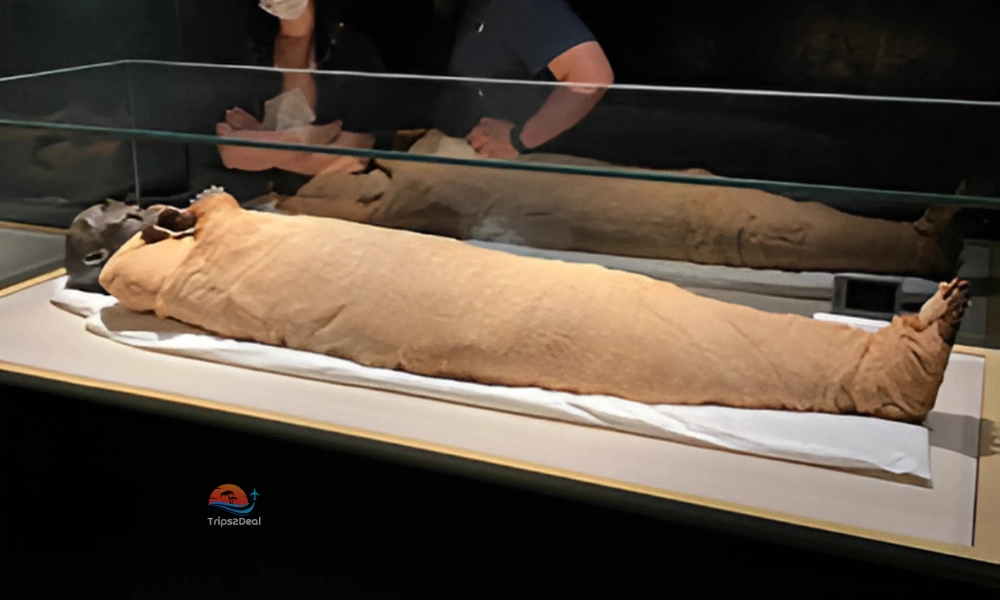Blogs

Royal Mummy Room
The room that offered you an unparalleled glimpse of the ancient Egyptian royalty which is nestled in the iconic Egyptian Museum (now in NMCE) of Cairo. It has the remains of some powerful pharaohs of ancient Egypt which work as a bridge to take you in the past. Visitors can witness the eternal rest of the Egyptian great rulers. The Egyptian Museum was established in 1902 in order to display the artifacts of ancient Egyptians for the world. Its royal mummy room played a vital role in giving fame globally.
Table of Contents
- Practice of Mummification in Ancient Egypt
- Significance of Royal Mummies
- Discovery of the Royal Mummies
- Journey of Mummies from Tomb to Museum
- Royal Mummy Room: What to Expect
- Most Famous Mummies in Room
- Scientific Discoveries from the Royal Mummies
- Transition to the National Museum of Egyptian Civilization (NMEC)
Practice of Mummification in Ancient Egypt
Ancient Egyptian beliefs on the afterlife, for which they do the mummification process that was a part of their culture. They had a belief that the soul needed a preserved body for the afterlife after death. So, they preserved the dead bodies of especially the elite and royalty members through the process of mummification. This process includes the removal of the internal organs, drying the body with natron and wrapping it with linen. They also craved the spells from the book of the dead for the safe passage to the afterlife. This represents the deep spiritual connection to immortality of an ancient Egyptian.
Significance of Royal Mummies
Pharaohs were not only rulers for them; they hold a status of god on earth. Doing the mummification of the pharaohs was a sacred act for them in order to maintain the power, religious devotion and cultural identity for the afterlife. Also, they decorated the tombs with hieroglyphs, treasures and archeological marvels. This act was to ensure to maintain their status and ensure their influence endured in the afterlife.
Discovery of the Royal Mummies
Most of the royal mummies were discovered during the 19th and early 20th century. In 1881, the discovery of the mummies' cache Deir el-Bahari (TT320) was a significant find that revealed more than 40 royal mummies. These mummies were hidden by the priests of ancient time in order to protect them from tomb robbers. The mummies of the Seti I and Ramses II were also found in this cache. Another key discovery was the discovery of the tomb KV35 in the valley of Kings. This tomb revealed the mummy of Amenhotep II and other unidentified royals.
Journey of Mummies from Tomb to Museum
In Early times mummies that were discovered were damaged a little bit by the excavators due to the lack of the method and techniques. But as the time passed and Egypt evolved and improved their techniques, they began to transport them to the museum in a very good way but still an ethical challenge for them. Some have the view to rebury them and some purposed to study and display. Finally, Egypt decided to exhibit them with dignity in order to educate the public globally and honor their heritage.
Royal Mummy Room: What to Expect
The royal mummy room is designed with an imbalance of temples and has a controlled environment in order to prevent decay. There is a cool temperature, low humidity and dim lightning in order to control the damage to the bodies. The mummies are placed in a glass case on which the information is displayed in bilingual language.

Most Famous Mummies in Room
There are 20 royal mummies on display from the ancient Egyptian mummies in the royal mummies room in the Egyptian museum (now in NMCE) in Cairo. Some famous mummies are:
- Ramses II: He is also known as Ramses the great, who ruled for 60 years and successfully led the military campaigns.
- Seti I: The mummy of Seti I presents the exquisite preservation as his tomb is the most beautiful tomb found in the valley of kings. He was a father of Ramses II.
- Hatshepsut: The female pharaoh of ancient Egypt who had contributed to the great monumental construction projects. A DNA test confirmed her identity and link to royal families.
- Seqenenre Tao: The mummy that got the severe head wound because he died in a battle against the Hyksos invaders.
- Yuya and Thuya: These were considered non-royals but possibly the grandparents of Tutankhamun as their tomb holds a great wealth of artifacts.
More royal mummies in the royal mummy room:
- Ahmose-Nefertari
- Ahmose I.
- Meritamun
- Thutmose II
- Thutmose III
- Amenhotep III
- Queen Tiye
- Merenptah
- Seti II
- Siptah
- Ramesses III
- Ramesses IV
- Ramesses V
- Ramesses VI
Scientific Discoveries from the Royal Mummies
In these modern days the scientists reveal many secrets that help the archaeologist and history explorer in understanding the cause of death of royal pharaohs. The modern ct-scan technology allows them to find the reason of death as they find signs of arthritis and dental issues. The facial reconstruction technology brings back the faces of ancient pharaohs back to the public and also allows us to understand the royal lineage.
Transition to the National Museum of Egyptian Civilization (NMEC)
In 2021, the Pharaohs’ Golden Parade to NMCE was held in which the 22 royal mummies were transported to the NMEC ( National Museum of Egyptian Civilization ). These mummies are now placed in NMEC where you can have a more interactive experience. Their chambers provide details of their death, discoveries and lives.
There are critics from the world about the exhibits of the dead that are unethical and disrespectful to them. But some of them considered it to be displayed for educational purposes in order to learn about the history and culture of ancient Egypt. Egyptians considered it as a pride to have these ancient mummies and to keep them on display to show the world.
The royal mummy room in the NMCE ( National Museum of Egyptian CIvilization ) is a cornerstone of historical preservation. It allows the visitor to see the bodies of the ones who were gods in ancient times. It provides a window to the past to understand the history of ancient Egypt and its rulers from time to time. Visiting this room is not seeing death, it's the visit to witness the civilization that shaped the world.





